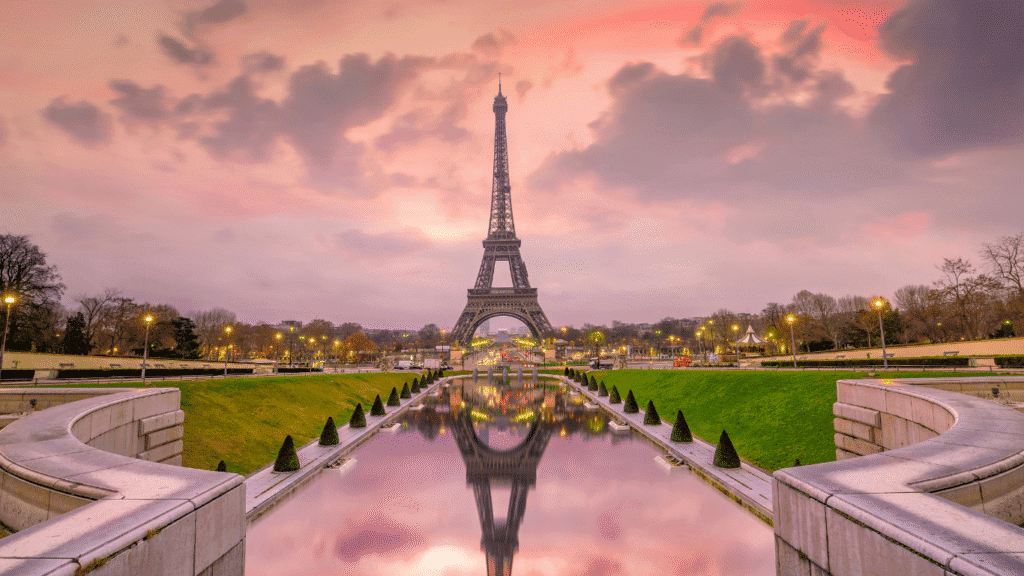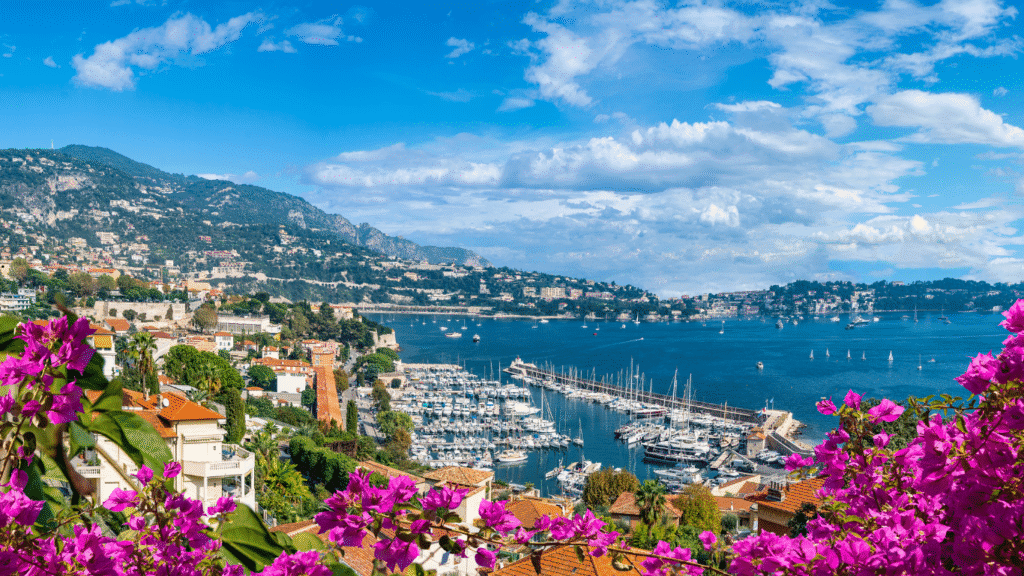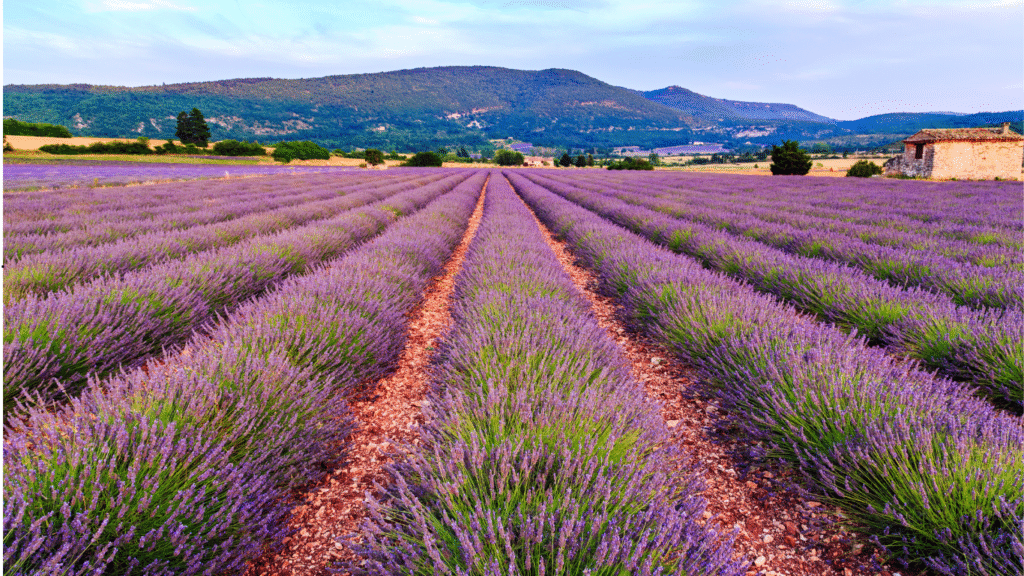France is a country that captivates with its rich history, artistic masterpieces, and exquisite cuisine. Whether you’re dreaming of strolling along the Seine, cycling through lavender fields, or basking on the beaches of the French Riviera, this ultimate travel guide will help you plan your perfect French vacation. We’ll cover everything from must-see destinations to practical tips for a seamless journey, including a smart way to stay connected with an eSIM.

The Best Time to Visit France
Choosing the right time to visit France depends entirely on your travel style and preferences.
- Spring (April-May): This is arguably one of the best times to visit. The weather is mild and pleasant, gardens are in full bloom, and major cities are less crowded than in the peak summer months. It’s a perfect season for sightseeing, enjoying outdoor cafes, and seeing the countryside come to life.
- Summer (June-August): The high season brings warm, sunny weather, especially in the south. However, it also means larger crowds, higher prices for flights and accommodations, and long queues at popular attractions. This is the ideal time for enjoying the beaches of the French Riviera or seeing the breathtaking lavender fields in Provence, but be prepared for the crowds and book your arrangements well in advance.
- Autumn (September-October): The shoulder season is a fantastic time for food and wine lovers. The weather is still pleasant, and the autumn colors are stunning, particularly in the vineyards. Crowds begin to thin out, and you can get better deals on hotels and flights, making it a great time for a more relaxed trip.
- Winter (November-March): While cold, this season has its own unique charm. Paris is enchanting during the holidays, with festive markets and lights that transform the city into a winter wonderland. Skiing enthusiasts can head to the Alps for world-class resorts. Prices are generally at their lowest, making it a great time for budget-conscious travelers.
Must-Visit Destinations in France
Paris: The City of Light
Paris is an eternal favorite, offering a blend of iconic landmarks and hidden gems. Your Parisian adventure should include a visit to the Eiffel Tower, the world-renowned Louvre Museum to see the Mona Lisa and other masterpieces, and a stroll through the historic Montmartre district to admire its artistic legacy and the stunning Sacré-Cœur Basilica. The city’s charm lies in its hidden cafes, fragrant boulangeries, and the simple pleasure of people-watching from a sidewalk bistro. Consider a relaxing boat cruise on the Seine for a unique view of the city’s monuments. Don’t forget to explore the Latin Quarter, with its ancient Sorbonne University, and climb to the top of the Arc de Triomphe for panoramic views of the Champs-Élysées.
The French Riviera: A Taste of Mediterranean Glamour
For sun and glamour, head to the Mediterranean coast, known as the Côte d’Azur. Destinations like Nice, with its pebble beaches and vibrant Promenade des Anglais, Cannes, famous for its film festival and luxurious yachts, and the chic seaside town of Saint-Tropez offer a taste of the high life. The deep blue sea and picturesque villages perched on cliffs, like Èze, make it a destination you won’t forget. Don’t miss the chance to explore the local markets in Nice for fresh produce and flowers, or visit the art museums dedicated to artists like Henri Matisse and Marc Chagall.

Provence: A Rural Escape
Escape to the countryside of Provence, a region famous for its rolling hills, olive groves, and fragrant lavender fields. Visit during the summer to see the lavender in full bloom—a truly breathtaking sight. Explore charming towns like Avignon, home to the immense Palais des Papes, and Aix-en-Provence, with its elegant fountains and tree-lined Cours Mirabeau. The region is also a foodie’s paradise, where you can indulge in local dishes like ratatouille and tapenade. For wine lovers, the vineyards of Châteauneuf-du-Pape and Bandol are a must-visit.

Normandy: History and Beauty
For history buffs, Normandy offers a moving journey back in time. Visit the D-Day landing beaches and pay your respects at the American Cemetery. The region is also famous for its stunning coastal landscapes, picturesque half-timbered towns like Honfleur, and the awe-inspiring Mont Saint-Michel, a medieval abbey perched on a tidal island. Don’t leave without tasting the local cider and creamy Camembert cheese.
The Loire Valley: Castles and Vineyards
The Loire Valley is a fairy-tale destination filled with magnificent châteaux. This UNESCO World Heritage site is home to over 300 castles, including the grand Chambord, the elegant Chenonceau, and the romantic Villandry with its stunning gardens. You can explore the castles by car, bicycle, or even hot air balloon. The region is also a key wine producer, so be sure to sample some of the local Sauvignon Blanc and Cabernet Franc.
Planning Your Trip: Practical Tips
Visa and Entry Requirements
For travelers from the United States, Canada, Australia, and many other countries, France is part of the Schengen Area, allowing you to stay for up to 90 days within a 180-day period without a visa. Your passport must be valid for at least three months beyond your intended date of departure from the Schengen Area. Always check the latest visa requirements for your nationality before you travel.
Getting Around
France has an excellent and efficient public transportation network.
- High-Speed Rail (TGV): The TGV is the best way to travel between major cities. It’s fast, comfortable, and a more eco-friendly option than flying. Book your tickets in advance for the best prices.
- Regional Trains (TER): These trains connect smaller towns and are perfect for day trips.
- City Transportation: Major cities like Paris have comprehensive metro and bus systems. Consider purchasing a multi-day pass to save money.
- Renting a Car: For exploring the beautiful rural landscapes of Provence or the D-Day landing beaches in Normandy, renting a car gives you the most flexibility to travel at your own pace. Be aware of traffic in major cities and the “péage” (toll roads) on many of the highways.
Staying Connected with a Digital SIM
One of the most important aspects of modern travel is staying connected, and an eSIM (embedded SIM) offers a convenient, digital solution. The Spark Roam eSIM service is a fantastic option for travelers as it allows you to get instant access to affordable data plans in over 200 countries, including all of France. You can purchase a plan online before you even leave home and activate it by scanning a QR code or through the Spark Roam app. This means you can have a high-speed internet connection as soon as you land, without the need for a physical SIM card. It’s a fantastic way to ensure you can use maps for navigation, translation apps to communicate, and stay in touch with family and friends without worrying about expensive roaming fees. Browse Spark Roam France eSIM plans here to find the perfect package for your trip.
Budgeting for Your Trip
France can accommodate a wide range of budgets. Here’s a general breakdown of daily costs per person (excluding international flights):
- Budget (€50-€80): This budget requires staying in hostels or budget hotels, eating from bakeries and grocery stores, and relying on public transportation. You can find free attractions like walking tours or many of the large parks.
- Mid-Range (€100-€200): You can afford comfortable hotels, enjoy meals at a mix of bistros and cafes, and take the occasional taxi or train. Many museums offer discounts on certain days or for students.
- Luxury (€300+): This allows for high-end hotels, fine dining experiences at Michelin-starred restaurants, and private guided tours.
French Culture and Etiquette
French culture is known for its elegance and a certain code of conduct.
- Greetings: Always say “Bonjour” when entering a store, cafe, or greeting someone. Use “Au revoir” when leaving.
- Dining: Don’t rush your meal. French dining is a leisurely affair. Wait for the host to say “Bon appétit” before you start eating.
- Tipping: Service is usually included in the bill (“service compris“), but it’s customary to leave a small tip (a few Euros) for good service, especially at nice restaurants.
A Sample 7-Day Paris Itinerary
- Day 1: Arrival and The Heart of Paris: Arrive at Charles de Gaulle (CDG) or Orly (ORY) airport. Take the RER B train into the city center. Settle into your hotel and take a leisurely walk along the Seine River, admiring the beautiful bridges and buildings. End the day with a visit to the Eiffel Tower as it lights up at night, a truly spectacular sight.
- Day 2: Art and History: Dedicate the morning to the Louvre Museum. To save time, buy tickets online in advance and focus on a few key sections. Afterwards, stroll through the Tuileries Garden to Place de la Concorde. In the afternoon, visit the Musée d’Orsay, housed in a magnificent former railway station, to admire Impressionist and Post-Impressionist masterpieces.
- Day 3: Montmartre and Sacré-Cœur: Explore the charming, bohemian neighborhood of Montmartre. Watch the artists at Place du Tertre and then visit the stunning white basilica of Sacré-Cœur, offering one of the best views of the city. Afterwards, enjoy a crêpe from a street vendor and explore the local art galleries.
- Day 4: Day Trip to Versailles: Take a morning train to Versailles and spend the day exploring the opulent Palace of Versailles and its vast gardens. The Hall of Mirrors and the fountains are must-sees. The gardens are so large that renting a golf cart or bicycle is a great idea to cover more ground.
- Day 5: The Latin Quarter and Notre-Dame: Discover the intellectual heart of Paris, the Latin Quarter. Explore the bookstores like Shakespeare and Company, and see the exterior of the historic Notre-Dame Cathedral. In the evening, enjoy a traditional French meal in the area and soak up the lively student atmosphere.
- Day 6: Fashion and Shopping: Walk along the famous Champs-Élysées, browsing the luxury boutiques and flagship stores. In the afternoon, explore the Marais district, a blend of historical charm and trendy boutiques. For a taste of local life, visit one of the many market streets, like Rue Montorgueil.
- Day 7: Departure: Enjoy one last French pastry and coffee before heading to the airport for your flight home.
A Deeper Dive into French Cuisine
French cuisine is a journey in itself. Don’t miss out on these staples, and be adventurous in trying regional specialties!
- Croissants and Pain au Chocolat: These classic pastries are a must for breakfast from any local boulangerie. Enjoy them with a café au lait.
- Crêpes: Enjoy these thin, delicate pancakes, available in both sweet and savory versions. A classic sweet crêpe is topped with Nutella, while a savory galette can be filled with ham, cheese, and a fried egg.
- Macarons: A delightful meringue-based confection with a variety of flavors and colors. Try a box from a famous patisserie like Ladurée or Pierre Hermé.
- Cheese and Wine: The ultimate French pairing. Visit a local fromagerie to sample different cheeses and ask for wine recommendations. Each region has its own unique cheeses, so be adventurous!
- Baguette: The iconic French bread. Find a fresh baguette from a boulangerie and enjoy it with cheese or ham for a simple but delicious meal.
- Bouillabaisse: A traditional fish stew from Marseille, rich in flavor and typically served with rouille and croutons.
- Coq au Vin: A classic dish of chicken braised with wine, mushrooms, and garlic.
- Cassoulet: A rich, slow-cooked casserole from the southwest of France, containing meat and white beans. It’s a hearty and comforting dish, perfect for a cold evening.
- Escargots: Snails cooked in garlic, parsley, and butter. A classic French appetizer for the more adventurous eater.
- Steak Frites: A simple but beloved dish of steak served with a pile of french fries.
Enjoy your trip to France! With a little planning and an open mind, you’re sure to create unforgettable memories.

